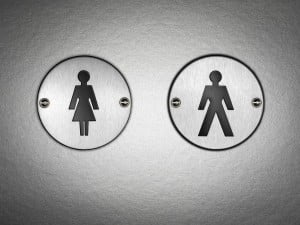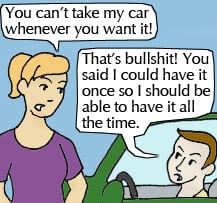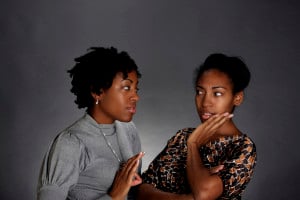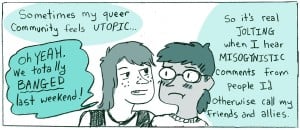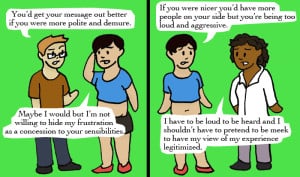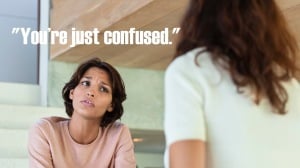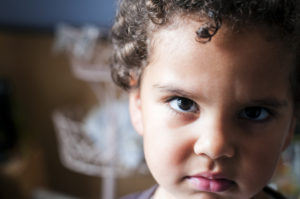Love it, hate it, or love deconstructing what there is to hate about it, most of us can’t forget the landmark entrance into Lena Dunham’s Girls that found us following one of its main characters, Jessa, as she and her friends navigate her scheduled abortion.
And if you’re anything like me, you probably watched the episode in a state of disbelief at how profoundly relatable the story was – because many of us have either experienced it ourselves or have been the friend there experiencing it alongside of somebody we care about.
The series tackled abortion in only the second episode, and many applauded the show’s bravery in addressing a still-taboo subject matter so early on.
Girls didn’t shy away from abortion, or fail to name it for what is was. In fact, in the short half-hour episode, the characters uttered the word itself eleven times – and if you think that isn’t outside of the norm, I’d kindly invite you to review basically any other show tackling the topic and compare.
Seriously.
But even if it succeeded in attempting to normalize the term, many loudly objected to the show’s handling of the subject matter.
You see, although Jessa opted for and scheduled her abortion, she didn’t actually have one. Shortly before she was to undergo the procedure, she miscarried (or got her period and wasn’t pregnant in the first place – the truth is actually unclear).
And that right there is one of the problems we consistently encounter with abortion in the media. Even in a media and societal landscape that increasingly allows us to bring up the subject, we aren’t seeing real and honest depictions of those who actually have an abortion.
This is especially astounding when we consider how often people are having them.
According to Advocates for Youth, one in three women in the United States will have an abortion in their lifetime – and this doesn’t even take into account that not everyone who has had an abortion identifies as a woman. That likely means that someone you know and care about has gone through it themselves, even if you don’t know about it.
That leaves us with an important question: If almost everybody knows somebody who has had an abortion, why doesn’t the media show us this reality?
Well, the truth is that although the procedure is common, it’s also incredibly stigmatized, and that means that nobody talks about it. Those who have had an abortion are largely shamed and silenced in a country where access to the procedure is growing increasingly rare and reactions to those who have them more and more hostile.
So that leads us to yet another question: What can we do to change that?
Media makers in particular are key stakeholders in making a difference when it comes to depictions of abortion. Media has the power to normalize the stigmatized, shifting public opinions and helping to inform the masses about things that they’ve been consistently misinformed about.
So here are three demands we should be making on the media to help destigmatize abortion and shift the way the public sees the procedure.
1. Depict Abortion Experiences That Are Nuanced
Like Jessa in Girls, far too often, abortion storylines are regulated to side narratives that never even pan out.
We see it time and time again. Think of Knocked Up, Juno, Grey’s Anatomy, and Mad Men who all saw their main characters either choose not to go through with their abortions or the choice is made for them and they miscarry or discover they were never pregnant to begin with.
Which is fine in and of itself. To be clear, there should be space to tell these stories too – they’re realities that many of us have faced. But we also need to see people actually having an abortion, not just thinking about having one.
I want to see people on my television having abortions. I want to see them thinking it through, weighing the options, and choosing what’s best for themselves and their families. I want to see people at the clinic, filling out the paperwork.
I want to see them in the procedure room talking to the doctor. I want to see them after their abortions as they wait to go home and in their kitchens having a bowl of cereal the next day.
I want to see people so sure about their choice they don’t think twice, and I want to see people not as sure, but who end up making the decision that’s right for them. I want to see people who never think about their abortions again, as well as people for whom they become a formative experience that impacts their entire life.
These are all things that people experience every single day, and I want to see them on screen. I demand to see them because representation is important, and we all deserve to see the real experiences we have day-in-and-day-out in the media. That’s the only way we can normalize these experiences.
So who has done this well? Who can we use as a role model, going forward?
Perhaps one of the best examples of abortion in film comes from Jenny Slate’s wonderful 2014 comedy Obvious Child.
In the movie, we find the main character, Donna, become unexpectedly pregnant after a drunken encounter with a man she meets at a bar. In a refreshing take on the subject, the entire film is about Slate’s journey as she decides on and goes through with the procedure.
We see her discuss it with her family and friends and find that her best friend Nellie had an abortion as a teen and never regrets it. She even describes the procedure, telling Slate’s character that it didn’t hurt and lasted only five minutes.
When Donna again opens up about needing an abortion, this time to her mother, she finds that she had one, too. Over the course of the film, we see three different women of different ages who chose abortion for varied reasons and different points throughout their lives.
Finally, we see Donna have her own abortion, following her through the clinic and after the procedure.
And this is exactly what we need. We need more examples of people talking about their abortions on screen in order to normalize it.
Because just like Donna found in Obvious Child, when we start having these conversations, we find that more and more people are willing to speak up and answer that yes, they’ve gone through it, too.
2. Show the Diversity in People Having Abortions
I also want to see all the people who have abortions.
Women, women of color, teens, mothers, trans men, non-binary people – everybody! I want to see people experiencing what all of these people actually experience.
Abortion is far too often framed by the media and even by many feminists as simply a women’s issue – and one only young unmarried women in particular deal with – but this is far from the truth.
Although we mostly see white high school and college-aged girls getting abortions time and time again on TV (think Amy on Parenthood or even again to Girls), they are by no stretch the only ones who actually get them.
And these depictions minimize the amount of people impacted by abortion and erase a lot of the people who have them.
In truth, the people who get abortions are as diverse as you can imagine.
According to the Guttmacher Institute, six in ten people getting an abortion already have children and “[n]o racial or ethnic group makes up a majority” of those who undergo the procedure.
3. Do Away with Misinformation and Anti-Choice Scare Tactics in Media
The thing is, though: We don’t just need to see abortions. We also need to see factual representations of what abortion actually looks like.
Far too often, when we see an abortion in a movie or TV show, those procedures don’t really match up with what they look like in real life.
Instead, we find ourselves continuously encountering myths straight out of the anti-choice playbook – the very same ones meant to restrict access to the procedure and shame those who have them in the first place.
Consider this: A 2013 study of abortion in popular media found that 14% of those who consider having one as part of their storyline are killed off, and 60% of those deaths are from the procedure itself.
That might lead one to think that abortion is dangerous, but that is a far cry from the truth. The abortions we see in film and TV that kill off characters are only reflective of a culture making its best effort to further stigmatize the procedure.
In reality, abortion is one of the safest medical procedures out there. The actual risk of death from abortion is less than 0.05%. You’re more likely to die in childbirth, hernia surgery, or even getting a colonoscopy than you are to die after getting an abortion.
Another common abortion trope used in media is the faulty claim that having an abortion will hurt your future ability to conceive.
You probably remember this one from House of Cards, when a doctor revealed to Claire Underwood that her past abortions meant that she wouldn’t be able to carry a child now. But this myth is actually just a frequently used scare tactic of anti-choice groups trying to stop people from getting an abortion.
Meanwhile, numerous studies have found no link between abortion and future fertility.
Instead of depicting abortion using medical falsehoods and anti-choice scare tactics, we need more factual and honest representations that show abortion for what it is: just something that happens to some people.
If I can take you all the way back for a moment to my pre-teen years, let’s revisit one of my all-time favorite shows, Degrassi: The Next Generation.
Several seasons in, we find one of our main characters, Manny, pregnant by leather-jacket clad resident heartbreaker Craig.
Manny doesn’t want a child. She isn’t ready to have one, and so she makes the decision that is right for her. In a two-episode arc that encompasses her making the decision, finding her mother (surprisingly) supportive of her, and going through with the procedure, the main takeaway is that abortion is just something that happens.
Manny teaches us that abortion is a choice you make, and even if it’s difficult, it’s something you can get through. After an abortion, you’re still you. You keep living your life, you learn from it, and that’s it. No scare tactics necessary.
***
It may seem like the plot of Grey’s Anatomy doesn’t matter beyond your Thursday night live-tweeting session, but the stories told there and the way they are told pack a punch.
If we have any hope of rolling back the stigma around abortion, we need real, truthful, and nuanced representations of it in popular culture.
That kind of representation – those truths – are the only way to create a societal shift in the way we perceive abortion.
[do_widget id=’text-101′]
Ally Boguhn is a Contributing Writer for Everyday Feminism and a feminist activist and media researcher living and working in Washington, DC. She completed both her B.A. in Communications and Art History as well as her M.S. in Professional Communications at Clark University, where she researched abortion debate rhetoric. Ally is also the founder and editor of Because I am a Woman, a blog devoted to intersectional feminism and reproductive justice. You can follow Ally on Twitter @AllyBoguhn. Read her articles.
Search our 3000+ articles!
Read our articles about:
Our online racial justice training
Used by hundreds of universities, non-profits, and businesses.
Click to learn more
Most Read Articles
- « Previous
- 1
- …
- 30
- 31
- 32






